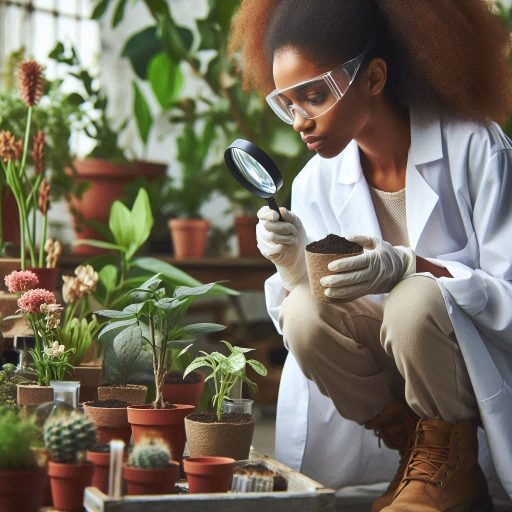Introduction
Soil biodiversity refers to the variety of life found within the soil, including microorganisms, fungi, insects, and larger organisms like earthworms.
This biodiversity is crucial for maintaining healthy ecosystems and ensuring the sustainability of our food systems.
Healthy soils serve as the foundation for plant growth and play a significant role in nutrient cycling, water retention, and carbon sequestration.
Understanding soil biodiversity helps us recognize the intricate relationships among soil organisms and their contributions to ecosystem functions.
Studying soil biodiversity is essential for several reasons.
First, it provides insights into how ecosystems function and adapt to environmental changes.
Healthy soil ecosystems enhance plant productivity and resilience against pests and diseases.
Furthermore, increased soil biodiversity can improve soil structure and fertility, leading to better crop yields and sustainable agricultural practices.
By understanding these dynamics, we can develop strategies to protect and restore degraded soils.
Soil scientists play a vital role in exploring soil biodiversity.
They study the composition and interactions of soil organisms, examining how these relationships affect overall soil health.
Their research informs practices that enhance soil quality and promote sustainable land management.
Through their work, soil scientists contribute significantly to our understanding of how to protect this invaluable resource, ensuring that future generations can rely on healthy soils for their agricultural and ecological needs.
Read: Organizations & Associations for Environmental Scientists in the USA
What is soil biodiversity?
Definition of Soil Biodiversity
Soil biodiversity refers to the variety of living organisms found in soil.
This includes microorganisms, insects, plants, and larger animals.
Each component plays a crucial role in maintaining soil health and ecosystem sustainability.
Different Components of Soil Biodiversity
Microorganisms, such as bacteria and fungi, are vital for nutrient cycling.
They decompose organic matter, releasing nutrients back into the soil.
This process supports plant growth and helps maintain soil structure.
Fungi also form symbiotic relationships with plant roots, enhancing nutrient uptake.
Insects contribute to soil biodiversity in several ways.
They aerate the soil, facilitating water infiltration and root penetration.
Many insects, like earthworms, break down organic matter, enriching the soil with nutrients.
Additionally, insects serve as food for larger animals, linking soil health to broader ecosystem dynamics.
Plants, both above and below ground, are essential for soil biodiversity.
Roots anchor the soil, preventing erosion and promoting stability.
They also interact with soil organisms, exchanging nutrients and water.
Different plant species support diverse communities of microorganisms and insects, creating a complex web of interactions.
Importance of Maintaining Healthy Soil Biodiversity for Ecosystem Sustainability
Maintaining healthy soil biodiversity is vital for ecosystem sustainability.
Healthy soils support robust plant growth, leading to increased agricultural productivity.
Diverse soil communities can also enhance resilience against pests and diseases.
This resilience reduces the need for chemical fertilizers and pesticides, promoting environmentally friendly farming practices.
Soil biodiversity contributes to ecosystem services, such as clean water and air.
Healthy soils filter pollutants and store carbon, helping mitigate climate change.
Biodiverse soils also support a wide range of plant and animal life, ensuring balanced ecosystems.
Human activities, such as deforestation, agriculture, and urbanization, threaten soil biodiversity.
Soil degradation leads to reduced fertility, impacting food production.
It is essential to adopt sustainable land management practices to protect soil biodiversity.
Practices like crop rotation, cover cropping, and reduced tillage can enhance soil health and biodiversity.
Investing in soil biodiversity research is crucial for future sustainability.
Soil scientists explore the intricate relationships among soil organisms.
Understanding these connections can lead to better management strategies for soil health.
Soil biodiversity is a key component of healthy ecosystems.
It supports food production, clean water, and climate regulation.
Protecting and enhancing soil biodiversity should be a priority for all.
Soil biodiversity is fundamental to the health of our planet.
By understanding and valuing this biodiversity, we can work towards a sustainable future.
Healthy soils foster thriving ecosystems, benefiting both nature and humanity.
Read: U.S. Cities with the Most Opportunities for Environmental Scientists
The Methods Used by Soil Scientists to Study Soil Biodiversity
Soil scientists employ various methods to study soil biodiversity effectively.
These methods help identify the composition and health of soil ecosystems.
Soil Sampling Techniques
Soil sampling is a fundamental method used by soil scientists.
They collect soil samples from different locations and depths to analyze biodiversity.
Proper sampling techniques ensure that samples represent the entire soil profile.
This process provides insights into the distribution of organisms in various soil types.
DNA Sequencing for Microbial Identification
DNA sequencing has revolutionized the study of soil biodiversity.
Scientists extract DNA from soil samples to identify microbial communities.
This method allows for the detection of organisms that are difficult to culture in the lab.
DNA sequencing provides a comprehensive understanding of microbial diversity and their functions.
Bioindicator Species for Assessing Soil Health
Bioindicator species serve as important tools for assessing soil health.
These species, such as specific plants or insects, indicate the overall condition of the soil.
Monitoring bioindicator species helps scientists understand changes in soil biodiversity.
Their presence or absence can signal shifts in soil quality and ecosystem health.
Soil biodiversity is fundamental to the health of our planet.
By understanding and valuing this biodiversity, we can work towards a sustainable future.
Healthy soils foster thriving ecosystems, benefiting both nature and humanity.
Case Studies of Soil Scientists Exploring Soil Biodiversity
Soil scientists conduct numerous case studies to investigate soil biodiversity effectively.
These studies shed light on the complexities of soil ecosystems and the impacts of human activities.
Research Projects Focused on Investigating Soil Microbial Communities
One notable research project involved studying microbial communities in agricultural soils.
Scientists collected soil samples from various farms, analyzing their microbial diversity.
This study revealed how different farming practices affect microbial populations.
It emphasized the importance of sustainable agriculture in preserving soil biodiversity.
Studies on the Impact of Land Use Changes on Soil Biodiversity
Another significant study examined the impact of land use changes on soil biodiversity.
Researchers compared soils in forested areas with those in urban settings.
The findings indicated that urbanization dramatically reduced soil biodiversity.
This study highlighted the need for urban planning that considers soil health and biodiversity conservation.
Collaborations with Conservation Organizations to Protect Soil Biodiversity Hotspots
Soil scientists often collaborate with conservation organizations to protect soil biodiversity hotspots.
One project focused on restoring degraded wetlands, critical for maintaining soil health.
By working together, scientists and conservationists identified strategies to enhance biodiversity.
These efforts involved planting native vegetation and implementing sustainable land management practices.
Soil biodiversity is fundamental to the health of our planet.
By understanding and valuing this biodiversity, we can work towards a sustainable future.
Healthy soils foster thriving ecosystems, benefiting both nature and humanity.
Read: Environmental Scientist vs. Ecologist: Roles and Differences in the US

See Related Content: Balancing Fieldwork and Office Work in Epidemiology
Challenges Faced by Soil Scientists in Studying Soil Biodiversity
Soil scientists encounter various challenges while exploring soil biodiversity.
Three significant hurdles stand out: lack of funding for research projects, difficulty in accessing remote soil habitats, and limited public awareness of the importance of soil biodiversity.
Lack of Funding for Research Projects
One major issue is the lack of funding for research projects.
Financial constraints often limit the scope and depth of soil studies.
Many researchers struggle to secure grants for essential experiments and fieldwork.
This financial barrier hinders their ability to make significant discoveries.
As a result, crucial areas of soil biodiversity remain understudied.
Difficulty in Accessing Remote Soil Habitats
Accessing remote soil habitats also presents considerable challenges.
Many vital ecosystems exist in hard-to-reach areas, making research difficult.
Scientists often require specialized equipment and support to study these locations.
Transporting materials and personnel to remote sites can be both time-consuming and costly.
Additionally, adverse weather conditions can further complicate access to these crucial habitats.
These logistical hurdles can deter scientists from pursuing important research.
Limited Public Awareness of the Importance of Soil Biodiversity
Limited public awareness of soil biodiversity compounds these challenges.
Many people underestimate the importance of healthy soil ecosystems.
This lack of understanding can result in fewer resources allocated to soil research.
Soil biodiversity plays a vital role in ecosystem health, agriculture, and climate regulation.
Yet, the general public often remains unaware of its significance.
The intersection of these challenges creates a daunting landscape for soil scientists.
Without adequate funding, many essential research projects cannot progress.
Furthermore, without public interest, it becomes difficult to advocate for more resources.
This situation often leads to a cycle of underfunding and undervaluation of soil studies.
Soil scientists strive to raise awareness about their work and its importance.
They engage with communities to share their findings and explain the significance of soil biodiversity.
However, breaking through the barrier of public indifference remains a persistent struggle.
Many scientists believe that education is key to increasing awareness.
They hope to inspire future generations to appreciate and protect soil ecosystems.
Advocacy for soil research must continue to grow.
More educational initiatives can help bridge the gap between scientists and the public.
Collaboration between scientists, policymakers, and educators can drive change.
Increased funding and support for soil biodiversity studies will benefit everyone.
Ultimately, overcoming these challenges is crucial for sustainable environmental management.
Soil scientists play a vital role in understanding the intricate relationships within soil ecosystems.
Their work impacts agriculture, conservation, and climate resilience.
Addressing funding issues, improving access to remote areas, and raising public awareness are essential steps.
By tackling these challenges, scientists can unlock the full potential of soil biodiversity research.
Transform Your Career Today
Unlock a personalized career strategy that drives real results. Get tailored advice and a roadmap designed just for you.
Start NowRead: The Relationship Between U.S. Policy & Environmental Scientist Roles
Uncover the Details: Biomedical Engineering: The Role in Aging Population Care
The Future of Soil Biodiversity Research
The future of soil biodiversity research looks promising due to several emerging trends.
Advances in technology, interdisciplinary collaborations, and increased public awareness are shaping this vital field.
These developments hold the potential to transform how we understand and conserve soil ecosystems.
Advances in Technology for Studying Soil Microbiomes
Advancements in technology play a crucial role in studying soil microbiomes.
Innovative tools, such as high-throughput sequencing, enable scientists to analyze complex microbial communities.
These technologies provide detailed insights into soil composition and function.
Additionally, remote sensing and imaging techniques allow researchers to assess soil health over large areas.
These tools enhance our ability to monitor changes in soil biodiversity and ecosystem services.
Furthermore, machine learning and artificial intelligence are increasingly applied to soil research.
These technologies can analyze vast datasets, identifying patterns and trends that may go unnoticed.
By harnessing these advancements, scientists can make more informed decisions regarding soil management and conservation strategies.
The integration of technology into soil research will deepen our understanding of microbial interactions and their impact on ecosystems.
Collaborations Between Soil Scientists and Other Disciplines
Collaborations between soil scientists and other disciplines are also vital for future research.
Interdisciplinary approaches that include ecology, agriculture, and environmental science can yield comprehensive insights.
These collaborations enable the sharing of knowledge and resources, leading to innovative solutions for soil conservation challenges.
For example, integrating agricultural practices with soil health management can enhance both productivity and sustainability.
By working together, scientists can address complex issues such as climate change, food security, and habitat loss.
Collaborative research initiatives can help develop sustainable farming practices that promote soil biodiversity.
These partnerships will be essential in developing strategies to combat soil degradation and promote resilience in ecosystems.
Importance of Educating the Public on Soil Biodiversity Conservation
Educating the public on soil biodiversity conservation is critical for fostering a culture of stewardship.
Increased awareness can lead to greater support for soil research and conservation efforts.
Public engagement initiatives, such as workshops and community programs, can help bridge the knowledge gap.
When individuals understand the value of healthy soil ecosystems, they become more likely to advocate for their protection.
Moreover, integrating soil education into school curricula can inspire future generations.
Teaching students about the importance of soil biodiversity can cultivate a sense of responsibility towards environmental conservation.
Empowering communities with knowledge will drive grassroots efforts to protect and restore soil ecosystems.
The future of soil biodiversity research is bright, driven by technological advancements and interdisciplinary collaborations.
As we enhance our understanding of soil ecosystems, we must prioritize public education on their importance.
By working together, we can ensure the preservation of soil biodiversity for generations to come.
This collective effort will ultimately lead to healthier ecosystems and a more sustainable future.
Conclusion
Soil biodiversity plays a vital role in ecosystem health and sustainability.
It supports plant growth, nutrient cycling, and climate regulation.
Healthy soils promote robust food systems and biodiversity above ground, which are essential for maintaining ecological balance.
Soil organisms, including bacteria, fungi, and insects, work together to decompose organic matter and enhance soil structure.
This intricate web of life contributes to our planet’s resilience against climate change and environmental degradation.
Soil scientists are essential in exploring and protecting this crucial resource.
They study soil organisms and their interactions, providing insights into soil health and functionality.
Their research informs conservation strategies and sustainable land management practices.
By understanding the complex relationships within soils, scientists can develop approaches to restore degraded lands and promote biodiversity.
Individuals can contribute to soil biodiversity conservation efforts in several meaningful ways.
Support local organic farming and sustainable agriculture initiatives that prioritize soil health.
Advocate for policies that protect natural habitats and promote practices that enrich soil biodiversity.
Participate in community projects focused on soil conservation, such as tree planting and restoration efforts.
Educate others about the importance of healthy soils and the role they play in our food systems.




